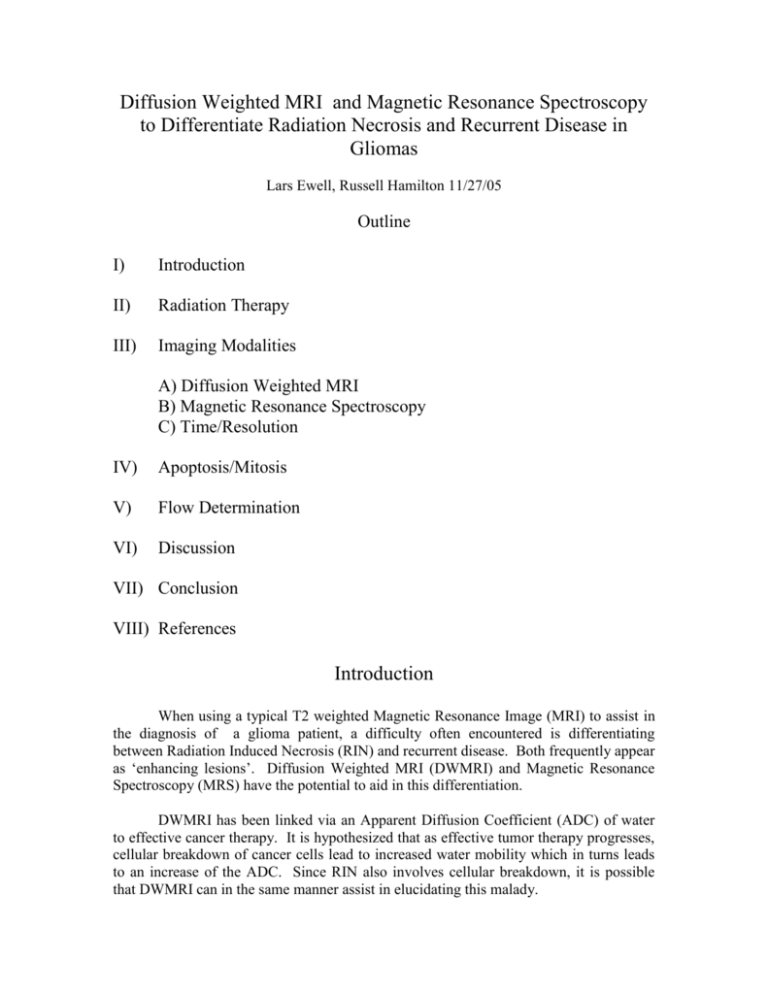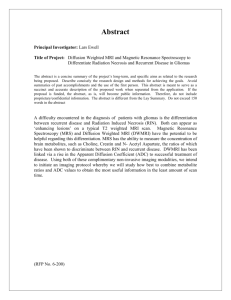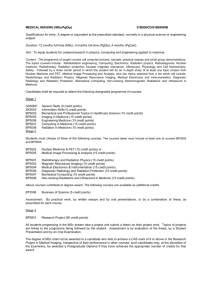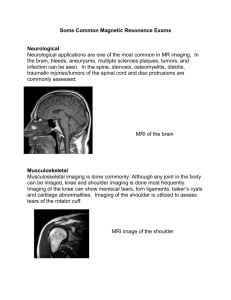Diffusion Weighted MRI and Magnetic Resonance - U
advertisement

Diffusion Weighted MRI and Magnetic Resonance Spectroscopy to Differentiate Radiation Necrosis and Recurrent Disease in Gliomas Lars Ewell, Russell Hamilton 11/27/05 Outline I) Introduction II) Radiation Therapy III) Imaging Modalities A) Diffusion Weighted MRI B) Magnetic Resonance Spectroscopy C) Time/Resolution IV) Apoptosis/Mitosis V) Flow Determination VI) Discussion VII) Conclusion VIII) References Introduction When using a typical T2 weighted Magnetic Resonance Image (MRI) to assist in the diagnosis of a glioma patient, a difficulty often encountered is differentiating between Radiation Induced Necrosis (RIN) and recurrent disease. Both frequently appear as ‘enhancing lesions’. Diffusion Weighted MRI (DWMRI) and Magnetic Resonance Spectroscopy (MRS) have the potential to aid in this differentiation. DWMRI has been linked via an Apparent Diffusion Coefficient (ADC) of water to effective cancer therapy. It is hypothesized that as effective tumor therapy progresses, cellular breakdown of cancer cells lead to increased water mobility which in turns leads to an increase of the ADC. Since RIN also involves cellular breakdown, it is possible that DWMRI can in the same manner assist in elucidating this malady. MRS has the ability to measure the concentration of brain metabolites, such as Choline, Creatin and N-Acetyl Aspartate, the ratios of which have been shown to discriminate between RIN and recurrent disease. There are two problems associated with MRS: 1) Limited resolution. 2) Increased scan time required. These problems, and others, will be addressed. We plan on initiating an imaging protocol for patients that have been treated with hypo-fractionated Intensity Modulated Radiation Therapy (IMRT) from our recently purchased Novalis Brainlab linear accelerator, as described below. We will study how best to implement these two complimentary non-invasive imaging modalities, so as to obtain the most useful information in the least amount of scan time. Radiation Therapy Hypo-fractionated IMRT for glioblastoma has been shown to be an effective means to deliver an acceptable dose in a shorter amount of time (1). We plan on administering a dose of between 50 and 80 Gy via IMRT in five equal fractions on our recently acquired Novalis Brainlab linear accelerator1. After surgical resection, but prior to receiving any radiation therapy, all of the patients enrolled in the imaging protocol will receive an initial CT scan used to plan the radiation therapy. In addition to the CT, a baseline set of MRI scans, including DWMRI and MRS will be taken prior to therapy. The MRI scans will be registered with the CT scans using the Brainscan planning software, which uses mutual information as a similarity measure to fuse the two different sets of images(2). Once these images are fused, the radiation oncologist and neurosurgeon will contour the region to be treated and radiation therapy will commence. After five fractions (one Fx/day), the initial round of radiotherapy will be done. An advantage of using this system is that the radiation isodose distributions can be superimposed upon the fused CT-MRI images. By doing this, it may be possible to correlate radiation induced changes with individual isodose curves. In addition to this, the thin (3mm) W leaves in the Multi-Leaf Collimator (MLC) of this machine allow for a very high degree of dose conformality (3). This high conformality could prove useful if, e.g., it is shown that patients may benefit if an area, e.g. the periphery, of a tumor is given a higher radiation dose. 1 Note: Hypo-fractionated radiotherapy has been used for some time here in the department of Radiation Oncology at the University of Arizona. This imaging proposal is not intended to effect in any way, the decision of what type of radiation therapy is prescribed for an individual patient. The neural cells in the brain are generally thought of as a ‘late-responding’ tissue with respect to radiation (4). In this regards, we do not expect to see any evidence of RIN for some months after the cessation of radiotherapy. Imaging Modalities Diffusion Weighted MRI As indicated above, DWMRI has been linked via a rise in the ADC of water with effective therapy, and visa versa (5,6). While this is certainly a useful application of this new imaging modality, it is not specifically what we propose to do. Since necrotic tissue, cancerous or otherwise, is thought to undergo cellular breakdown leading to increased water mobility, it has been suggested that DWMRI could also be useful in discriminating between RIN and recurrent disease. In the laboratory, melanoma xenografts were imaged using DWMRI in an attempt to delineate necrotic tumor fraction. While the results were promising, the limited resolution of the DWMRI images used at that time prevented smaller lesions from being measured (7). In the clinic, DWMRI has been used in an attempt to differentiate RIN from recurrent disease with mixed results. Some investigators have indicated it has provided no additional information above MRS in discrimination (8,9), while others have reported that DWMRI can aid (10,11). One of the main goals of this study is to settle the question of whether or not DWMRI can assist in discrimination of RIN and recurrent disease. In both the laboratory and the clinic, the limited resolution of DWMRI was mentioned as a potential reason why this imaging modality had restricted usefulness in differentiating RIN from recurrent disease. With this in mind, and for the isotropic diffusion that we are interested in, we plan on implementing a new method of DWMRI, Radial Fast Spin Echo (RFSE), that promises higher resolution and reduced imaging time (12). In this method, the diffusion weighting direction is varied during acquisition of a full radial k-space data set such that images reconstructed from the data have effectively isotropic weighting. This allows for reduction in artifacts due to susceptibility gradients, as well as motion. In Figure 1, two diffusion weighted images are displayed (12). As can be seen, the RFSE image has better resolution than the more typical Single Shot Echo Planar Image (SSEPI). Magnetic Resonance Spectroscopy MRS, also known as Chemical Shift Imaging (CSI), has proven useful in discriminating between RIN and recurrent disease. It can determine metabolite levels, the ratios of which have the ability to differentiate. MRS obtains its signal from the shift Figure 1: Two diffusion weighted images of a stroke victim: a) A trace image using Single Shot Echo Planar Imaging (SSEPI). b) An isotropic Radial Fast Spin Echo (RFSE) image of the same patient(12). a) b) Figure 2: a) T1 weighted MRI scan of a healthy volunteer. b) Corresponding MRS (CSI) scan of red inset showing Cho, Cr and NAA peaks. The vertical axis is the strength of the MR signal, and the horizontal axis is the shift in frequency in parts per million (ppm). in the MR signal due to the surrounding chemical environment (13). Regarding the brain, three of the main metabolites of interest are: 1) Choline (Cho) a neurotransmitter that is increased in tumors. 2) N-Acetyl Aspartate (NAA) a neuronal metabolite that is decreased in tumors (13). 3) Creatin (Cr), a brain metabolite. In Figure 2, a T1 weighted MRI along with an MRS spectra of a healthy volunteer is displayed. Ratio Metabolite Ratios for Different Tissue 5 4.5 4 3.5 3 2.5 2 1.5 1 0.5 0 Cho/Cr Cho/NAA NAA/Cr 1 Recurrent Tumor 2 Radiation Induced Necrosis 3 White Matter Figure 3: Metabolite ratios for different tissue types (15). It has been revealed that the Cho to Cr and Cho to NAA ratios are generally highest in recurrent tumor, followed by RIN and finally normal appearing white matter (15). This is depicted graphically in Figure 3. Time/Resolution As indicated above, two of the disadvantages of MRS are the limited resolution and the long scan time required. In past studies using MRS, scans have taken on average 1.5 hours (14). A goal of this study is to quantify, and attempt to minimize, the amount of time necessary to obtain a useful set of images. While the method of using RFSE for the DWMRI should save an amount of time, the majority of time spent in imaging these patients will be for the MRS. Another area where these two different imaging modalities differ is in resolution. As indicated in the Experimental Methodology section, 3D multivoxel data acquisition will be used for the MRS. We expect that the 3D resolution of these scans will be on the order of 1cc. In contrast, the resolution for the DWMRI scans will be approximately 1mm2 in the non-scan direction, and a slice thickness of 3mm. Consequently, there will be approximately 3x10x10 or 300 DWMRI voxels for each MRS voxel. We will combine the DWMRI voxels to get an average ADC for each of the larger MRS voxels, but will also examine the smaller detail that the DRMWI images afford, as well as the normal MRI images. Apoptosis/Mitosis The two primary mechanisms of clonogenic cell death following irradiation are mitotic death and apoptosis (4). Mitotic death, which occurs when cells fail to divide because of damaged or lost chromosomal material or the failure of spindle formation during cytokinesis, is the most common mechanism. One or more cell divisions may occur prior to cell death. Apoptosis prevalence depends strongly on the tumor type and occurs without cell division. The expected ADC signal is significantly different for mitotic and apoptotic death. Cells undergoing mitotic death increase their size, for example when giant cells with multiple nuclei form. The ADC is expected to decrease during this process since the intercellular spacing and fluid are reduced. Then these cells become necrotic and their membranes are compromised, resulting in excess intercellular fluid and expected increases in water mobility and the ADC. The duration of this process depends on the cell cycle time since cells undergo one or more cell divisions before dying. This would be considered a delayed response to radiation as it would occur days after exposure. In apoptotic death, the cell detaches from its neighbors, chromatin condenses at the nuclear membrane, cytoplasmic condensation causes the cell to shrink, and water is lost. An increase in ADC is expected to occur (16). Next, these cells become necrotic and are then phagocytized. During these processes, the ADC is expected to be larger than prior to irradiation. Apoptosis occurs within 4 to 24 hours following exposure. Finally, for either mechanism, the tissue in the irradiated volume must reorganize. The ADC in this region may be larger or smaller than in the pretreatment scan, depending on whether tumor or normal cells occupy this volume and their density within it. Flow Determination While DWMRI is sensitive to the amount of water mobility, Cerebral Blow Flow (CBF) has also been investigated as it relates to gliomas, mostly through perfusion studies (17,18). While we have no current plans to include perfusion related measurements in this study, we are cognizant of the of the fact that blood flow can make definitive diagnosis more difficult. By using a small amount of diffusion weighting in RFSE imaging, it has been shown that blood flow can be suppressed, thereby making lesion detection more reliable (19). In Figure 4, this technique is shown on a patient with a liver hemangioma. We intend on using similar techniques in the brains, as needed. Fig. 4. Axial images of a patient with a liver hemangioma. (a) Radial MR image acquired with conventional spatial saturation MRI pulses for flow suppression. (b) Radial MR image acquired with a small amount of diffusion weighting (b=1.2 s/mm2) in addition to the spatial saturation pulses to better suppress flow. The bright signal from vessels in (a), as those indicated by the arrows, is better suppressed throughout the slice in (b)(19). Discussion It appears likely that a lack of resolution is a major reason why the potential of DWMRI has not yet been realized with regards to differentiation of RIN and recurrent disease. In this regards, we are hopeful that the RFSE method of acquiring DWMRI images will be helpful. Conclusion To realize the full potential of these two complimentary non-invasive imaging modalities will take some time and effort. By initiating our protocol as soon as possible, we expect to be able to answer some very important questions about how best to obtain the ideal imaging sequence to achieve the best clinical outcome. References 1) Floyd N., et al., ‘Hypofractionated Intensity-Modulated Radiotherapy for Primary Glioblastoma Multiforme’, Int. J. Radiation Oncology Biol. Phys., 58, No. 3, pp. 721– 726, 2004. 2) P. Viola, I. Wells: “Alignment by Maximization of Mutual Information”, in Proc. International Conference on Computer Vision, Boston, pp. 16-23, 1995. 3) Monk et al., ‘Comparison of a Micro-multileaf Collimator With a 5-mm-leaf-width Collimator for Intracranial Stereotactic Radiotherapy’, Int. J. Radiation Oncology Biol. Phys., 57, No. 5, pp. 1443–1449, 2003. 4) Hall E. J., ‘Radiobiology for the Radiologist’, Fifth Edition, Lippincott Williams and Wilkins, Philadelphia, PA 2000. 5) Ross, B. D, et al., ‘Evaluation of Cancer Therapy Using Diffusion Magnetic Resonance Imaging’, Molecular Cancer Therapeutics., 2, 581–587, June 2003. 6) Theilmann R. et al., ‘Changes in Water Mobility Measured by Diffusion MRI Predict Response of Metastatic Breast Cancer to Chemotherapy’, Neoplasia, August, 2004. 7) Lyng et al., ‘Measurement of Cell Density and Necrotic Fraction in Human Melanoma Xenografts by Diffusion Weighted Magnetic Resonance Imaging’, Magnetic Resonance in Medicine, 43, 828-836, 2000. 8) Pauleit et al., ‘Can the Apparent Diffusion Coefficient Be Used as a Noninvasive Parameter to Distinguish Tumor Tissue From Peritumoral Tissue in Cerebral Gliomas?’, Journal of Magnetic Resonance Imaging 20:758–764 (2004). 9) Rock et al., ‘Associations Among Magnetic Resonance Spectroscopy, Apparent Diffusion Coefficients, and Image-Guided Histopathology with Special Attention to Radiation Necrosis’, Neurosurgery, Vol 54. No. 5, May, 2004 p. 1111-1119. 10) Asao C, et al., ‘Diffusion-Weighted Imaging of Radiation-Induced Brain Injury for Differentiation from Tumor Recurrence’, Am J Neuroradiol 26:1455–1460, June/July 2005. 11) Hein et al., ‘Diffusion – Weighted Imaging in the Follow up of Treated High Grade Gliomas: Tumor Recurrence versus Radiation Injury’, Am J Neuroradiol 25: 201-209, February 2004. 12) Sarlls et al., ‘Isotropic Diffusion Weighting in Radial Fast Spin-Echo Magnetic Resonance Imaging’, Magnetic Resonance in Medicine 53:1347–1354 (2005). 13).Haacke, Brown, Thompson and Venkatesan, ‘Magnetic Resonance Imaging’, 1999, John Wiley and Sons, Inc., 605 Third Ave.,NY, NY 10158-0012. 14) Pirzkall et al., ‘MR-Spectroscopy Guided Target Delineation for High-Grade Gliomas’, Int. J. Radiation Oncology Biol. Phys., 50, 4, pp. 915–928, 2001. 15).Weybright et al., ‘MR Spectroscopy in the Evaluation of Recurrent ContrastEnhancing Lesions in the Posterior Fossa After Tumor Treatment’, Neuroradiology, 46, 541-549, 2004. 16) Moffat et al., ‘Functional diffusion map: A noninvasive MRI biomarker for early stratification of clinical brain tumor response’, Proc. Nat. Ac. Sci. pp. 5524–5529, 102 no. 15, April 12, 2005. 17) Sugahara et al., ‘Posttherapeutic Intraaxial Brain Tumor: The Value of Perfusionsensitive Contrast-enhanced MR Imaging for Differentiating Tumor Recurrence from Nonneoplastic Contrast-enhancing Tissue’, AJNR Am J Neuroradiol 21:901–909, May 2000. 18) Eastwood et al., ‘Cerebral Blood Flow, Blood Volume, and Vascular Permeability of Cerebral Glioma Assessed with Dynamic CT Perfusion Imaging’, Neuroradiology (2003) 45: 373–376. 19) Knowles, et al., ‘A T2-Weighted Radial MRI Method for Imaging the Abdomen’, Poster 131 delivered at the Frontiers in Biomedical Research, 10/28/05, Univ. of Arizona, Tucson AZ (see http://www.omc.arizona.edu/forum/ ).









